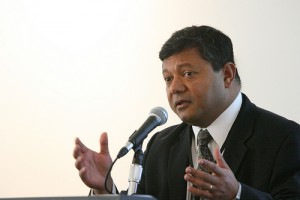
On October 19 Dr. Arun Majumdar presented a lecture titled “A New Industrial Revolution for a Sustainable Energy Future” as part of the Aerospace and Mechanical Engineering Distinguished Scholar Lecture series. Many students, staff, professors, and researches in the field gathered to listen to Dr. Majumdar’s lecture. The lecture focused on how the United States’ Industrial Revolution had historically impacted energy technologies and how the theory of transitioning to efficient solutions can be applicable to how we will use and shape our current energy resources. Through his research, Dr. Majumdar has led a phenomenal career in paving a path to the future of sustainable energy technologies.
The Industrial Revolution was a period when improvements in agriculture, manufacturing, mining, transportation, and technology sparked an era of social, economic, and cultural growth. The transformation of lifestyle made during the Industrial Revolution is arguably the most important human transition since the domestication of plants and animals. Dr. Majumdar noted the Industrial Revolution in his lecture as being “From horse power to horsepower”. The main mode of transportation in the 1800s was the use of horses and carriage. Due to innovation and support for transportation production, the transition from the horse to the automobile took place between the 1890s to the 1920s. In the span of only 30 years, the use of technology and innovation had influenced a change that has affected the way we see transportation forever. People transitioned to a better solution that provided a more efficient approach to production. Dr. Majumdar asked the audience:
“What are the better, cheaper, faster solutions that we have today?”
Although traditional energy resources like petroleum and coal were important to innovation during the Industrial Revolution, times have changed, and the shift from nonrenewable resources to renewable resources is taking place. Dr. Majumdar explained that the transition from the horse to the vehicle is much like the transition that needs to be made from nonrenewable resources to renewable resources. The energy system that the United States’ has supported for more than 200 years is creating an economic dilemma as well as presenting an even more apparent environmental impact on our earth. The need for better, cheaper, and faster renewable energy options is greater than it has ever been.
Some of the goals that Dr. Majumdar discussed to forecast the future of sustainable energy are achieved through higher efficiency rates. In regards to solar energy, Dr. Majumdar highlighted the Department of Energy’s SunShot Initiative. The SunShot Initiative’s plan is to reduce solar energy to a dollar per watt by 2020, which would ultimately make solar energy a cheaper alternative to traditional gas. Also noted was the Department of Energy’s goal on developing a more efficient and lighter engine for vehicles which consumes less fuel but still can go from 0 to 60mph in under five seconds. Dr. Majumdar explained that the transition to sustainable energy innovation and policy will improve the rate in which we utilize our transportation future.
Research and development for breakthrough clean technologies can enable new learning curves. In short, a learning curve is the rate at which productivity and efficiency affects an economy’s learning process. The learning curve is represented in a graphical representation that breaks down the overall changing rate of learning retention from the average individual. Through the innovation of energy researchers and the funding of projects dedicated to clean energy alternatives, the learning curve of Americans can increase to a broader approval of a sustainable energy future. “It is always hard to predict the future,” said Majumdar. “But the hope is to have multiple options”.
This lecture gives us the opportunity to discuss the pressing issue of transitioning from nonrenewable resources to renewable energy resources. The transition into the New Industrial Revolution will define the ways in which we utilize research and development to work toward benefiting our future economic, social, and cultural growth. Dr. Majumdar closed in saying,
“The capacity for the United States to innovate is absolutely spectacular. What we need is increased funding for sustainable policy and clean energy standards... If we don’t change the direction soon, we will end up where we are inevitably heading!”
Written by Gabrielle Olson, ASU LightWorks
Photo by Tom Story, ASU News.
Additional Information:
http://engineering.asu.edu/semte/seminars/mae/Majumdar%20Seminar%20Flyer01.pdf
http://energy.gov/articles/top-9-things-you-didn-t-know-about-alternative-fuel-vehicles